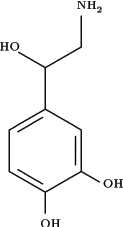The Norepinephrine Molecule

The chemical compound norepinephrine (NC8O3H11), also known as noradrenaline, is a catecholamine neurotransmitter hormone released from the adrenal glands that affects parts of the human brain where attention and impulsivity are controlled. This compound affects the fight-or-flight response, activating the sympathetic nervous system to directly increase heart rate, release energy from fat and increase muscle readiness. The prefix nor-, is derived from the German abbreviation for "N ohne Radikal" (N, the symbol for nitrogen, without radical),[2] referring to the absence of the methyl functional group at the nitrogen atom of epinephrine.

The host of physiological changes activated by a stressful event are unleashed in part by activation of a nucleus in the brain stem called the locus ceruleus. This nucleus is the origin of most norepinephrine pathways in the brain. Neurons using norepinephrine as their neurotransmitter project bilaterally from the locus ceruleus along distinct pathways to the cerebral cortex, limbic system, and the spinal cord, among other projections.
Norepinephrine is synthesized from dopamine by dopamine β-hydroxylase.[3] It is released from the adrenal medulla into the blood as a hormone, and is also a neurotransmitter in the central nervous system and sympathetic nervous system where it is released from noradrenergic neurons. The actions of norepinephrine are carried out via the binding to adrenergic receptors.
As a stress hormone, norepinephrine affects parts of the brain where attention and responding actions are controlled. Along with epinephrine, norepinephrine also underlies the fight-or-flight response, directly increasing heart rate, triggering the release of glucose from energy stores, and increasing blood flow to skeletal muscle.
However, when norepinephrine acts as a drug it will increase blood pressure, triggering a compensatory reflex that overcomes its direct stimulatory effects on the heart. The reflex, called the baroreceptor reflex, results in a drop in heart rate called reflex bradycardia.
Origins
Norepinephrine is released when a host of physiological changes are activated by a stressful event.
In the brain, this is caused in part by activation of an area of the brain stem called the locus ceruleus. This nucleus is the origin of most norepinephrine pathways in the brain. Neurons that are activated by norepinephrine project bilaterally (send signals to both sides of the brain) from the locus ceruleus along distinct pathways to many locations, including the cerebral cortex, limbic system, and the spinal cord, forming a neurotransmitter system. Norepinephrine is also released from postganglionic neurons of the sympathetic nervous system, to transmit the fight-or-flight response in each tissue respectively. The adrenal medulla can also be counted to such postganglionic nerve cells, although they release norepinephrine into the blood.
Receptor binding
- Norepinephrine performs its actions on the target cell by binding to and activating adrenergic receptors. The target cell expression of different types of receptors determines the ultimate cellular effect, and thus epinephrine has different actions on different cell types.
References
- Merck Index, 11th Edition, 6612.
- TIHKAL on "nor"
- Introduction to Autonomic Pharmacology. Elsevier International.
- Rang, H. P. (2003). Pharmacology. Edinburgh: Churchill Livingstone. ISBN 0-443-07145-4. Page 167